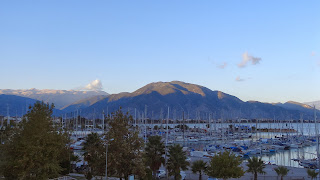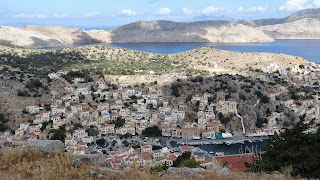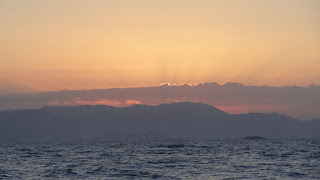Finike itself is an unremarkable town in the tourist sense. It has
been settled for thousands of years and is named after its founders, the
Phoenicians. The land-use policy in force favours agriculture, not
development and there are no tourist attractions in the town itself. Many
older people retire here for the peace and quiet! It has good facilities
and a very friendly population.
Saturday’s market is excellent. It’s good to be settled in a ‘real’
working town rather than a tourist development – everything we need is nearby,
and it won’t close down in the winter.
These guys sell cheese, yoghurt and fresh butter. The yoghurt is thicker and richer than anything we've ever had. It is a great dessert drizzled with lots of local honey and walnuts (they're in season so there are massive amounts of them in the market for very little money)
They also sell a great range of olives, olive pastes and oil.
Our Saturday treat is to buy a filled pancake from these ladies. I like the spinach and cheese stuffed ones, Terry likes the potato and chilli ones. $1.25 for one this size. We just sit down on tiny toy chairs alongside and eat them.
This is where we get our dried fruits and nuts. He also sells Turkish confectionary, including Turkish Delight and multi-coloured jubes.
http://en.wikipedia.org/wiki/Finike
The surrounding areas do contain places of great interest, though, as
Lycia's capital city was located a few
miles from here. This was Limyra, and is closest to Finike.
Farther inland was Arycanda.
Apparently it was a bit of a pariah in Lycian
times and only had one vote in the Lycian system, while more responsible towns
had 3 votes (An Electoral College system,
adopted by the USA!) The reason for this was that it was known as
a Party Town and was forever in debt, not taking life as seriously as other
cities.
Further west by some 30km is the much larger town of Demre, which is famous
for having St Nicholas as its Bishop for many years. We visited his
church, remarkably well kept and being tended to by the Turkish Antiquities
departments. It is a simple, austere building – quite a contrast with the
elaborate festival that ‘Christmas’ has become. A shopkeeper in Antalya pointed
out to me the irony that all of the Christmas traditions – St Nick, presents,
cypress pines, snow – are Turkish, but none of it is celebrated in Muslim
Turkey. St Nicholas is the patron saint of both Greece and Russia and a great
number of Russian faithful make a pilgrimage here. There was a large
group visiting when we were there and they certainly take their devotion to St
Nicholas very seriously, young and old alike, with much kneeling, crossing and
prostrating in each part of the church itself.
The church contains his tomb but not his remains, as these were stolen
by the Italians several hundred years ago.
The marina is one of the best we have been in and is filling up rapidly with
wintering cruisers. We are looking forward to a full social program over
the coming cold months like yoga classes, Turkish language classes, computer
classes, organised trips to other parts of Turkey and weekend BBQs.
Had the first quiz night of the season on Thursday
night and partnered up with our new friends from Queensland, Gary and Louise on
Takamoana, a Fontaine Pajot
cat.
We won by ½ a point, a fine team
effort!
42 of us went off in two buses
to Antalya on Friday night for a performance of the Antalya Symphony
Orchestra.
It was a superb night out and a wonderful performance. Antalya is about 100km away so we were very late back, well past Cruisers’ Midnight, which is 9pm.
Our friends Hugh and Linda from the East Coast of the USA on
Wild Goose arrived a few days ago and
are only a few feet away on the opposite side of the pontoon. They’ve headed off
to explore Cappadocia – a trip we’ll take in a couple of weeks.
There is still plenty of good sailing weather ahead, and once the more
urgent matters are seen to, we can use the marina as a base for some short
trips along this lovely coast. We went out into the Bay last Sunday with
our friends from Malta (they’re actually from Sydney) the Richardsons, Sean,
Carol and the twins Elliott and Daniel.
We just went “around” and anchored over the other side for lunch before
heading back. They were great company, both on our little cruise and back in
Malta, where they treated us to a great home cooked Maltese meal. We wish them
all the best for the rest of their stay in Turkey and their final return to
Australia.

There were light winds, so we did some sailing and some motoring.
Getting in and out of your slip is easy here
as the marina staff offer excellent assistance in picking up the mooring lines
to help you dock. One guy even gets out of the dinghy with the forward
line in his hand and gets on your bow to secure the front while the other guy
heads to the dock to take your stern lines. Best system we have ever come
across and very experienced Marinaras (don't know what the Turkish word is).
And our bow thruster is now working properly again.
The plan is to head home in early December for about seven weeks, and we are
also thinking about a visit to the US to catch up with my mum.
PS I keep forgetting to document the amusing signs and brand names seen
along the way. Here are a couple of favourites for the record:
Kastrati petrol in Albania;
Morfat cake mixes in Greece;
Arcelik electronics in Turkey.













































